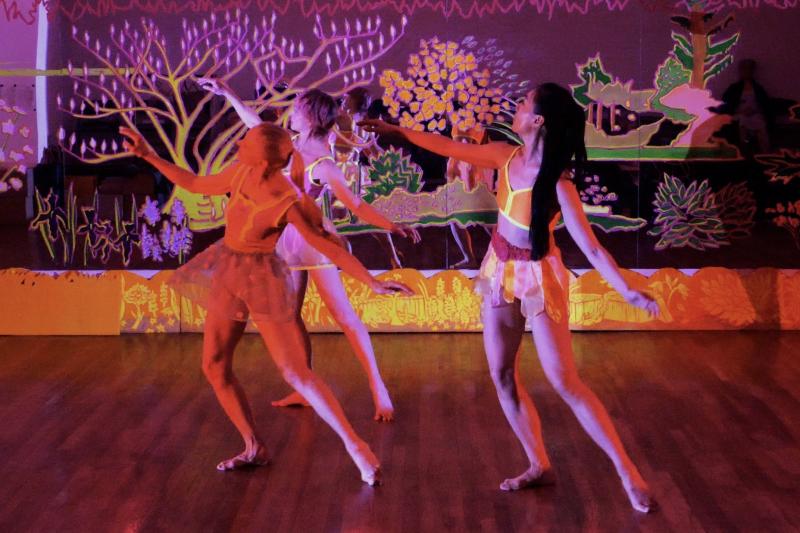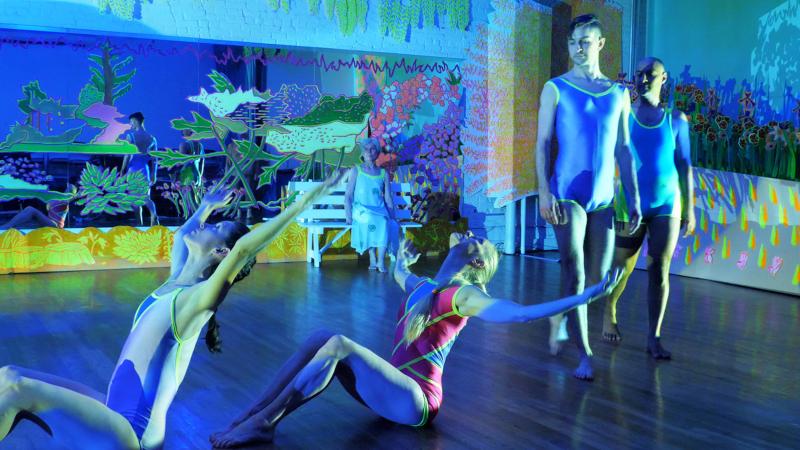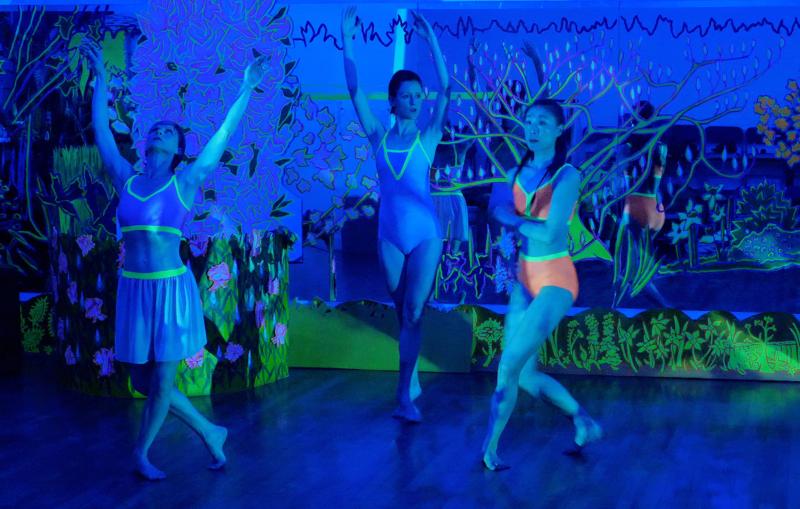April 2023 saw the premiere of Douglas Dunn + Dancers new work, Garden Party, a series of vignettes by choreographer Douglas Dunn, each with its own elegant and playful interaction of movement, visual art, music, and language. The creative collaborators were visual artist/designer Mimi Gross and lighting designer Lauren Parrish, who transformed the Douglas Dunn Studio loft space in downtown Manhattan into a verdant haven, with a lush garden landscape adorned with lighting and projections by Parrish illuminating each scene. Delicate texts, varied musical scores, and the intimacy of the space made the audience feel as if they were in a secret garden, not just looking at one.
Live Design chats with Parrish about her designs for this new piece, featuring 80-year-old dancer/choreographer Douglas Dunn himself!
Live Design: Can you describe the overall look for Garden Party?
Lauren Parrish: The look of Garden Party is a vibrant, wild, neon world that juxtaposes with the often romantic and personal nature of choreography, sound, and text in the piece.

LD: How did you and Mimi Gross collaborate in terms of integrating the lighting/projections with the scenic elements?
LP: I have always been very conscious that my work with projection and lighting is layering over both Mimi and Douglas' work. Their opinions and making sure I am tying their two parallel threads together is always in the back of mind. Often I am deferring to Mimi artistically in terms of color, but she is deferring to me in terms of space use so the technology can be hidden from view.
Mimi and I also have very different timelines to our processes. Mimi works far in advance establishing color palettes and spatial use because the timeline of building the costumes and set are much longer than my digital process. I am used to discussing concepts and storyboarding once the work is finished and developing my plan of action and executing it in less than a few weeks. Mimi had a maquette and wanted to see how projection and lighting would work with them at that point. I started making sample content to show Mimi roughly three months prior to tech. Then using a desktop projector mapped to the maquette with QLab, I showed her several pieces I had made and some stock footage. This exercise showed me what did or did not resonate with her. Mimi gravitated to bold color, more abstract images that didn't conflict with her painting and shadow play but not realistic images or dense moving textures. From then I started slowly building a library of images and ideas I could use together or separately once Douglas was ready to show me the completed work.
Mimi and I had the luxury of being in Douglas' space for multiple months prior to starting to tech—Mimi every day for several weeks, with my stopping every other week to prep power, test projectors, establish speaker placement, etc. This time has been really valuable for solving problems organically rather than the usual intense planning followed by a load in. For instance, I decided that I wanted the speakers US instead of near the audience to support the type of sound Douglas was using, I wanted the sound to come from in the world of the piece rather than be more of a surround concept. This conflicted with the original set placement. We were able to shift over a portion of the set two feet, the dancers had time to adapt to that and tell us if it was okay with spacing, and I had time to realize I hated how the black speakers looked and get yellow speaker cozies made. This whole process has been atypical of the short timelines I have worked on in the past and I have loved it.

LD: Use of color or movement in the lighting?
LP: The main challenge was, of course, the room—a white space with wood floors, mirrors on the back wall, and windows letting in tons of light (imagine your dream artist loft) that would be in use as the primary rehearsal space throughout. There were also no hanging positions and a minimal amount of power. For me the first rule of design is do not fight the space; the second is to find freedom in limitations. Rather than investing a lot of time and money in traditional lighting package, I pursued something that used what the space already had or would have, using as little power as possible.
We covered all the windows with photography backdrop paper I had left from another show or that Mimi was using in her design to create a better, but not perfect blackout. Photo backdrop paper is very thick and is already flame treated making it ideal for this application. I positioned the projectors inside the scenery pieces sitting on the floor where I would normally place ellipsoidal units as shins, angled slightly upstage to light as much of the space as possible without reflecting from the mirror into the audience's eyes. I chose projectors over lights so I could get a variety of colors and textures with one source, since each source meant having to cut a hole in the scenery to hide the "lighting" unit. I wanted to avoid that wherever possible because I was so in love with Mimi's design. I used Panasonic laser projectors specifically because I find their projector black to be excellent and their operation reliable.
There is a socket overhead every few feet for the studio lighting that I exchanged for the NYX bulbs to create a color changing ceiling of light that also allows me to tone the floor and shadows created by using fewer sources of light. I used a Doug Fleenor Pre-Set 10 Portable station so that people could turn the NYX bulbs on for rehearsals even when I was not present for rehearsals. Later, we added the reflector bells from clip lights to reflect as much of the light down as possible and it made a very visible difference, although I miss the glow on the ceiling. The Dark Lights are small, about the size of a lemon, and are attached to a lightweight curtain track that is built into the ceiling where the dressing room is, as well as to the top of cardboard scenic pieces right as you enter the space to highlight areas that the NYX bulbs cannot reach due to physical obstructions. Overall, the space is probably "darker" than a traditional theater housing dance that uses LEDs, but given that the relative brightness of all the elements allows me to blend them seamlessly together, it creates a cohesive visual experience for the audience. And I am safely using every watt of power in the room.

LD: What are the projections and did you do the content creation?
LP: The projections are primarily simple abstract images I drew in Procreate on a iPad with an Apple Pencil. I find brushes that have a good base texture and I edit them to get the density and fall-off I like. Each projection cue is using multiple images with different textures and colors so I can adjust the opacity in the room based on how the image looks on the bodies. With few sources of projection, adding textures over one another at an increasingly lower level of transparency to create a totally opaque image, creates the visual interest I crave and find lacking in traditional theater lighting. I tend to do more of my own content creation when lighting dance, since I like to be able to finely tweak where certain colors and lighter areas are depending on how the bodies move in space. I also tend to use still images with dance because both the dancers' bodies moving and the shadows created by those bodies are often a lot for the audience to absorb already— it can feel really chaotic if I add more motion. When I use projection for scenic design or immersive applications, I often build on and alter photographs and videos I take or that I license. There is only one of me and content creation can be incredibly time consuming. I have very little ego about admitting I cannot do it all well.
Gear list:
2 Panasonic PT-RZ970, 10k lumen,
1 DLP 1920x1200 projector with Lenses ET-DLE085 - 0.8-1.0 :1 zoom from Avancy Inc
16 Astera NYX bulbs with wireless transmitter from Port Lighting
12 Gantom Dark Lights embedded in and around scenery from Refraction Lighting and Sound
Doug Fleenor Preset 10 Portable
Mac Studio 2022 with M1 Max chip and 64GB of RAM courtesy
Figure 53 QLab 5
ETC EOS Software via a NOMAD dongle with 2 universes enabled
Several hundred feet of Cat6 cable
Many Ethernet to HDMI and Ethernet to USB-C adapters